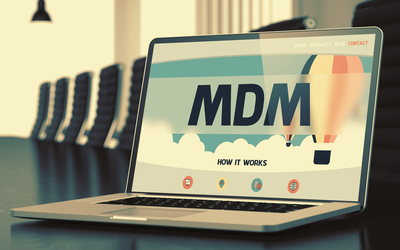The digital age is data driven. That fact should come as no surprise. It stands to reason, therefore, that any company desiring to succeed in the digital age needs the best possible master data management (MDM) solution to manage the oceans of data being generated each day. For some time, analysts have been telling companies organized around industrial age principles that they need to develop a digital transformation strategy that better equips them for doing business in the digital age (i.e., they need to transform into digital enterprises). Master data management needs to be part of that digital transformation strategy. Last year Jennifer Zaino (@Jenz514) reported, “Forrester Research in its Forrester Wave: Master Data Management, Q1 2016, points out that organizations’ needs are becoming more complex, with many companies tightly linking their MDM efforts to customer engagement and business processes, and with data models becoming more dimensional while data levels grow deeper.”[1] Whenever I hear the word “complex” linked to business activities, I automatically think about how cognitive computing can help. The fact that I’m President and CEO of a cognitive computing firm might have something to do with that reaction; but, I’m not alone in believing that smart solutions are needed to deal with the complexity of master data management.
Master Data Management and Data Integration
The digital age (sometimes called the information age) generates an enormous amount of data. Trying to integrate this data so it can be analyzed and leveraged is no small task. Bob Violino (@BobViolino) reports, “Organizations in the U.S. and U.K. are losing an aggregate $140 billion each year to disconnected data, according to a new study conducted by independent research firm Vanson Bourne and sponsored by data integration software provider SnapLogic.”[2] Sanjay Kumar adds, “Master data management is all about solving business issues and improving data trustworthiness through the effective and seamless integration of information with business processes.”[3] One of the reasons cognitive computing platforms provide superb foundations on which to build MDM solutions is that they can integrate and analyze both structured and unstructured data. In an earlier article, Kumar stated, “To stay competitive and grow in today’s market, it becomes necessary for organizations to closely correlate both internal and external data, and draw meaningful insights out of it. During the last decade a tremendous amount of data has been produced by internal and external sources in the form of structured, semi-structured and unstructured data. These are large quantities of human or machine generated data produced by heterogeneous sources like social media, field devices, call centers, enterprise applications, point of sale etc., in the form of text, image, video, PDF and more.”[4]
Since data is the lifeblood of digital enterprises, managing that data is like ensuring your body’s circulatory system is in good condition. Aaron Zornes (@azornes), chief research officer of The MDM Institute, observes, “The boring but strategic business processes of onboarding customers and suppliers, and transacting with your customers and suppliers remain fundamental business requirements … [and] cannot be ignored. … These business fundamentals are greatly enhanced by the quality data that MDM brings to the equation.”[5] Murat Asku, a consultant with Capgemini, adds, “Mastering data is really all about cross-reference between data sets.”[6] He offers three “truths” about data. They are:
- Data truth number 1: There’s more than one way to do it. Although there may not be a one-size-fits-all to MDM, Asku insists MDM is still a must. A company insisting on using a “non-automated way of managing data is likely to rupture, as processes, people and data sources inevitably change. The moment that diverse data sets are treated differently, it challenges the ability to cross-reference and create relationships between data from different sources. Suddenly the rules are no longer the same, and if no MDM tool or program in place to manage this, there’s a danger that things can go downhill pretty fast.”
- Data truth number 2: Data is now business-critical, whichever way you look at it. “That’s because robust MDM brings together governance, processes, standards and tools under one roof and sets unshakeable foundations for collecting, analyzing and leveraging data into a single view. So I’d argue that it’s still the key to making data invaluable.”
- Data truth number 3: MDM pretty much cannot fail to bring value. “Ultimately, the better the data, the better the insights — and the better the insights, the better the business decisions. That’s the most basic case for setting your MDM course and leaning on the necessary process and tools to make it work.”
Asku’s last point about making better decisions is important. Bain analysts, Michael C. Mankins and Lori Sherer (@lorisherer), note that decision making is one of the most important aspects of any business. “The best way to understand any company’s operations,” they write, “is to view them as a series of decisions.”[7] They explain:
“People in organizations make thousands of decisions every day. The decisions range from big, one-off strategic choices (such as where to locate the next multibillion-dollar plant) to everyday frontline decisions that add up to a lot of value over time (such as whether to suggest another purchase to a customer). In between those extremes are all the decisions that marketers, finance people, operations specialists and so on must make as they carry out their jobs week in and week out. We know from extensive research that decisions matter — a lot. Companies that make better decisions, make them faster and execute them more effectively than rivals nearly always turn in better financial performance. Not surprisingly, companies that employ advanced analytics to improve decision making and execution have the results to show for it.”
Cognitive computing can help improve data-driven insights and decision-making.
Summary
Kumar concludes, “An immature MDM program limits an organization’s ability to extract meaningful insights from big data. It is therefore of utmost importance for the organization to improve the maturity of the MDM program to harness the value of big data. MDM helps towards the effective management of master information coming from big data sources, by standardizing and storing in a central repository that is accessible to business units. … Big data analytics coupled with MDM backbone is going to offer the cutting edge advantage to enterprise towards managing the customer-centric functions and increasing profitability.” Aligning data is a critical step in helping align a company to achieve its overall goals and objectives. Cognitive computing and MDM are a powerful combination that can help companies transform into digital enterprises so they can thrive in the decades ahead.
Footnotes
[1] Jennifer Zaino, “A New Take on Master Data Management,” Dataversity, 14 July 2016.
[2] Bob Violino, “Disconnected data costs organizations $140B,” Information Management, 5 July 2017.
[3] Sanjay Kumar, “10 best practices for master data management,” Information Management, 30 may 2017.
[4] Sanjay Kumar, “Harnessing the value of big data with MDM,” Information Management, 1 February 2017.
[5] Aaron Zornes, “Master data management driving better business decisions, Information Management, 29 June 2017.
[6] Murat Asku, “To MDM Or Not To MDM? That Is The Question,” Information Management, 23 November 2015.
[7] Michael C. Mankins and Lori Sherer, “Creating value through advanced analytics,” Bain Brief, 11 February 2015.





